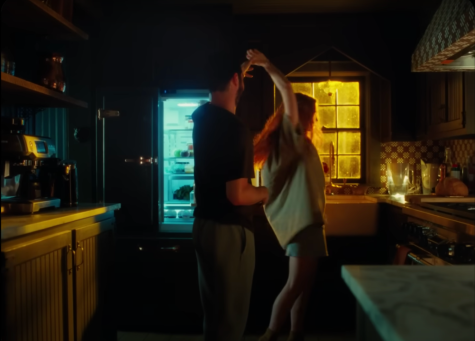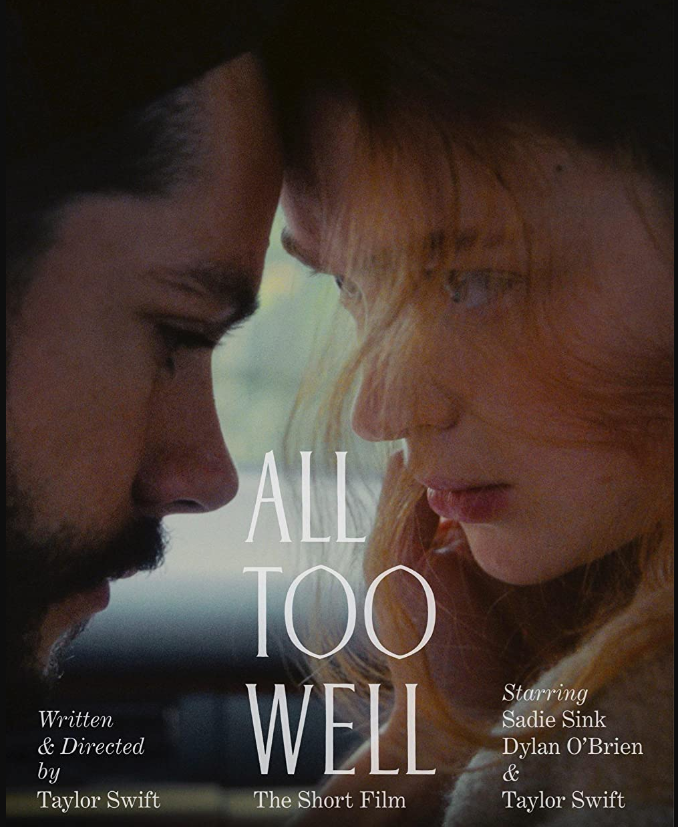“In the Cracks of Light” (All Too Well: The Short Film Version)
The Effect of Lighting in All Too Well: The Short Film
June 30, 2023
All Too Well: The Short Film was an ambitious endeavor for the singer-songwriter Taylor Swift, since it represents her longest format project yet. Set to her song “All Too Well (10 Minute Version) [Taylor’s Version] [From The Vault]” from her album Red (Taylor’s Version), the film’s seven chapters explore what Swift describes as “extreme guttural heartbreak at your most formative age that debilitates you emotionally for years.” With the help of actors Sadie Sink and Dylan O’Brien, playing the two main characters credited as “Her” and “Him,” the actors’ compelling performances and tangible chemistry help Swift convey nuanced aspects of love, loss, and pain in a relationship with a significant age gap. Through the strategic use of lighting that alternates between warm and cool tones, Swift conveys a story about initial love that grows into a faltering relationship and ends in intense heartbreak.
Swift purposefully adjusts the lighting throughout the short film, as warm and cool tones reinforce the phases of the relationship between “Him” and “Her.” Aligning with the first lyrics of the song “I walked through the door with you,” Swift depicts Sink walking into O’Brien’s character’s sister’s house. The camera pans from O’Brien to Sink, using a close-up shot to capture the woman’s infatuation in the beginning stages of their relationship. The shallow focus Swift employs helps capture this initial fascination as the two characters are in focus but the rest of the background is blurred. Essentially, they are the only ones that matter in these shots and in this honeymoon stage of their relationship. The scene is full of warm tones from the red and orange colors of Sink’s hair to her symbolic red scarf, brown outfit, and spectrum of brown and beige elements of the walls and staircase. With only a few sources of artificial light, the scene is primarily illuminated by warm sunlight filtering in through stained glass windows that brighten Sink and the warm colors of the scene. Stained glass windows are commonly used in religious settings as symbols of purity. Swift’s choice to diffuse light through them is symbolic of the pureness of the couple’s relationship at that moment.
The warm lighting sets a comforting mood that is sharply contrasted once the audience enters the man’s apartment in a later chapter of the film. During the couple’s argument in his kitchen, Swift employs a mix of shot-reverse-shot style and close-ups on Sink with O’Brien off-screen or in the background. Dishes are scattered throughout the kitchen following a dinner party with the man’s friends, and the tones are much cooler, reflecting a coldness in both “Him” himself and their relationship. The man’s kitchen walls and equipment are all gray and blue colors, and throughout the entire scene, there is bright blue light emanating from above the stove, illuminating the whole room in cool tones. Although the two characters are still together, there is a change in their relationship and a newfound coldness between them, reflected in this lighting, that was not present at the beginning of “An Upstate Escape” chapter but is very apparent in “The First Crack in the Glass.” Partially caused by their age gap and how “Her” has “one foot in girlhood, [and] one foot in this very adult world”, making her feel out of place in the man’s cultivated adult life, there is a strong contrast between her warmness and naivety and his mature and charming yet condescending and belittling demeanor, reflected in the cold, blue tones of the man’s environment as they experience the first signs of their relationship falling apart.

When 21-year-old “Her” attempts to fit into the man’s sophisticated, adult world, the difference in their age is abundantly clear as they are in completely different stages in their lives. At the dinner party in “The First Crack in the Glass,” Sink is wearing a red lip – typically a sign of maturity – as she attempts to fit in with the older crowd, yet she still felt like she didn’t belong, commenting “they’re all strangers, they’re all older than me.” This deep divide is naturally created by their age gap and is further reinforced throughout the film with strategic lighting choices as, even after the couple apologizes after their fight, the once warm tones are now partially cooler. As the characters dance together in the kitchen, although they seem to be sharing an intimate moment, Swift’s choice of lighting illuminates the division that will always naturally exist between them. As they laugh and “Him” twirls “Her” around, the camera captures the couple at eye level with the scene split in half by the tones of the backlighting. While Sink is illuminated by warm, yellow light coming in through the window, O’Brien is illuminated by the cold, blue refrigerator light. Thus, the coldness and the distance growing between them have not yet ruined their relationship, but it is encroaching on the formerly warm light that symbolized their initial attraction.
Due to the film’s short format, Swift has explained the importance of “mak[ing] technical, subtle decisions in terms of lighting” that help the audience understand significantly more about the characters through their surroundings as opposed to long dialogue. Throughout the remaining chapters of the film, Swift continues to alternate between warm and cool lighting to communicate the stages of the relationship ending in intense heartbreak. Especially in the final scene, thirteen years after the couple’s breakup, in the chapter “Thirteen Years Gone”, the mix of warm and cool tones assists Swift in highlighting how “Her” has both recovered and changed from the relationship. As an older “Her,” played by Swift herself, puts on jewelry, there is a close-up shot of the back of her head while a warm, red light illuminates the entire frame. However, as the scene switches to a long shot of her apartment, the zoomed-out view shows a combination of both cool and warm lighting to symbolize that while “Her” is still herself, she has been changed by her experience with “Him.” A wall physically divides the frame in two: half is filled with blue light that reflects her loss of innocence, while the other half is filled with yellow light, in other words, what remains of her former life before this relationship and debilitating heartbreak. Ultimately, as Swift described in a behind-the-scenes video, there is “a stoicism and a seriousness and a stillness but a sadness” within the older “Her.” She may still have elements of her past self – reflected in the remaining warm light – but she has taken something from this heartbreak and from “Him,” both good and bad, as depicted with the elements of cooler tones. After the audience watches “Her” come of age, the combination of warm and cool tones at the end reflects Swift’s message that the woman is “fine, but she’s not who we [initially] met.”
Throughout the short film, Swift uses lighting to portray the stages of the couple’s relationship from falling in love to heartbreak, reeling, and moving on. Swift employs warm or cool tones, or a mix of both, to illustrate the devastating reality of the painful barrier created and emphasized by strategic lighting choices as the man changes from the warmness of a main character to a cold, distant villain and eventually a bystander. Swift, informed by her personal experience, effectively portrays this complex dynamic in a painfully realistic way that utilizes lighting to bring the audience into the woman’s world as they “watch a person lose an element of innocence and naivety”, while also watching “Her” heal and “learn how to turn it into something beautiful.”


